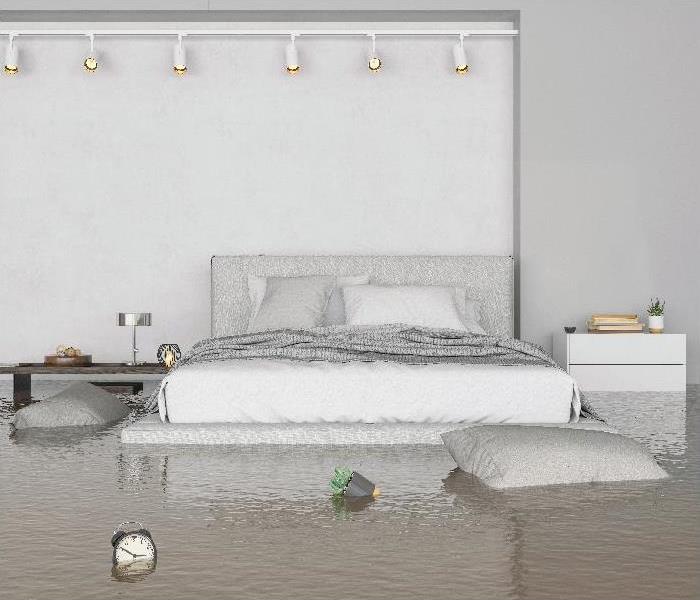How Does a Natural Scientific Principle Like Equilibrium Impact Drying in Destin?
9/18/2020 (Permalink)
Flood damage can be devastating to Destin homes, especially with the continual shift in airflow, humidity, and temperature.
After a water or flood disaster, professional restoration services hinge on experienced technicians providing more efficient solutions to harsh effects impacting Destin homes. Because flooding can quickly get out of control in susceptible properties constructed in known flood zones, elements like extraction often precede more direct drying and cleaning efforts. This process usually gets completed using multiple tools in the arsenal ranging from wet vacuums to submersible pumps.
Flood damage in Destin homes must get addressed as promptly as possible, as there are many materials and contents at stake when allowing standing water to persist. Even without direct contamination threats and overwhelming standing water situations, drying principles govern the efficiency and effectiveness of chosen equipment and practices. Experienced technicians like our SERVPRO team have a working knowledge of these essential drying principles to anticipate how varying conditions cause the environment to behave. A balance of three drying principles ensures efficient moisture removal and restoration:
• Airflow – Considering both the natural air movement through open space and the generated airflow from machines like air movers and desiccant dehumidifiers, regulating where air flows and what materials/spaces become impacted is vital to increasing the efficiency of drying.
• Temperature – Warmer temperatures are often ideal for evaporation and even most cleaning processes, as heat increases chemical reactions. Over-drying is a possibility, so temperatures should be continually monitored to ensure that they do not rise to undesirable levels that could damage materials and contents we attempt to restore.
• Humidity – The presence of moisture in every environment is unavoidable, but at specific percentages, relative humidity can become damaging to exposed materials and substantially slow the drying process.
How Does the Movement of Air Impact Drying Functions?
Our SERVPRO technicians must take heed of the environmental conditions in each workspace that we intend to dry. The equilibrium principles impact multiple vital factors in drying processes, including temperature, airflow, and relative humidity. With each of these factors' importance to efficient moisture removal, our technicians must remain continually aware of changing conditions caused both by the drying process and through vapor pressures and migration to even out the property.
• Moisture Differences – Properties are consistently seeking a balance of conditions, especially those vital to the drying process. Humid and dry spaces in the same house force air movement through materials to even out the moisture content across the open areas.
• Temperature Changes – When colder temperatures and warm temperatures share adjacent spaces, equilibrium is sought. Air moves through materials to regulate and balance the varying conditions.
• Vapor Barriers – Cooler temperatures and damp materials can prevent airflow through structural elements by creating a vapor barrier.
What Conditions Cause the Temperature to Change?
Temperature has an equal impact on the overall drying process, meaning that this is a condition that SERVPRO professionals must consistently monitor. Understanding ideal drying temperatures ensure that overdrying does not occur and that cooler conditions do not slow the evaporative process.
• Balance of the Environment – Often, the work zone is kept at a warmer temperature to promote faster evaporation, but this can also cause cooler rooms and areas adjacent to the drying zone to continually infiltrate this space in an attempt to equalize the overall temperature of the house.
• Drying Process – The evaporation of moisture trapped within the wall and flooring materials cools the immediate area. A cool air barrier can form over the affected surfaces making it more challenging to penetrate the surface for continued drying.
• External Factors – Open windows and doorways to cooler outside temperatures can directly impact the house's overall temperature - and thereby, the speed of drying.
Does a Present Moisture Influx Impact Drying Efficiency?
Higher humidity levels undoubtedly impact the pace and efficacy of drying methods. The greater the moisture content in the environment, the less efficient air movers and other drying equipment become. As much as air movers play a direct role in drying surface materials like drywall, flooring, and other exposed elements, moisture removal from materials often increases humidity in the room. The elevated moisture can make equipment like the low-grain refrigerant dehumidifiers work harder without more beneficial results.
Flooding is an unnatural occurrence that can be highly destructive to area residences. As overwhelming as the initial circumstances might appear, our SERVPRO of Fort Walton Beach team can provide an efficient response complete with all of the necessary tools and products. To make flood losses, “Like it never even happened,” give our rapid response team a call today at (850) 863-2552.






 24/7 Emergency Service
24/7 Emergency Service
